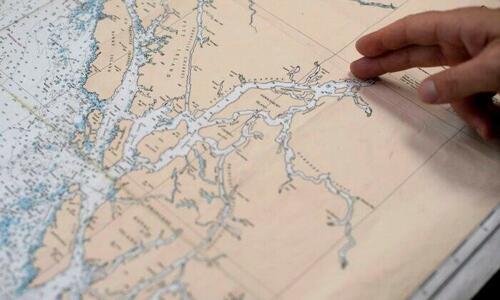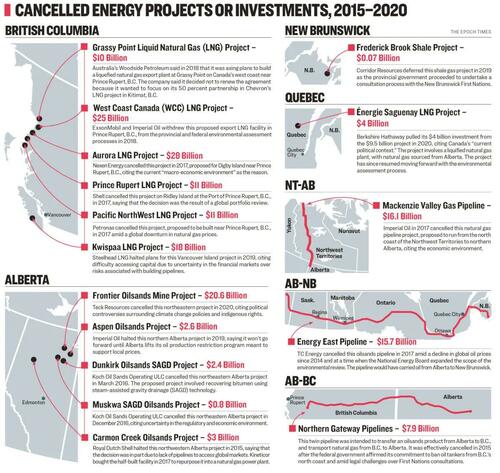
Визуализация всех отмененных энергетических проектов Канады
Автор: Омид Горейши, The Epoch Times (выделено нами),
В то время как сектор ресурсов Канады был поражен отменой разрешения на строительство трубопровода Keystone XL Соединенными Штатами. Канадские чиновники сталкиваются с еще одной проблемой, поскольку губернатор Мичигана пытается закрыть трубопровод Энбриджской линии 5.
 Предлагаемый маршрут танкера из Китимата, Британская Колумбия, связанный с проектом «Северный шлюз», показан на карте 19 сентября 2013 года. Проект был фактически отменен после того, как федеральное правительство запретило нефтяные танкеры с северного побережья Британской Колумбии. Канадская пресса/Джонатан Хейворд
Предлагаемый маршрут танкера из Китимата, Британская Колумбия, связанный с проектом «Северный шлюз», показан на карте 19 сентября 2013 года. Проект был фактически отменен после того, как федеральное правительство запретило нефтяные танкеры с северного побережья Британской Колумбии. Канадская пресса/Джонатан ХейвордТрубопровод Line 5, который пересекает Висконсин и Мичиган, доставляет нефть из Западной Канады на восток. где рафинируется в Сарнии, Онтарио, в такие продукты, как: бензин, дизельное топливо и топливо для отопления дома. Закрытие линии 5 окажет серьезное влияние на поставки сырой нефти в Восточную Канаду и обойдется в тысячи рабочих мест.
Некоторые активистские группы в Миннесоте также надеются остановить проект Enbridge Line 3 в Калгари, запустив юридические проблемы и даже надеясь, что президент США Джо Байден отменит проект, как он сделал Keystone XL. Линия 3, наряду с проектом расширения Транс-Маунтин и Keystone XL, до отзыва разрешения последней, являются тремя крупными проектами нефтепровода, которые в настоящее время ведутся в Канаде.
Но препятствия для канадских трубопроводных и ресурсных проектов не ограничиваются теми, которые пересекают границу. В последние годы в стране наблюдается ряд отмен и отсрочек по энергетическим проектам, расположенным в пределах ее собственных границ. Некоторые из них были обусловлены рыночными условиями и решениями владельцев о приоритетах. Однако значительное число проектов было отменено из-за неопределенности в процессе регулирования и экологической политике, а также из-за сложности консультаций с коренными народами.
Оттава ввела новое экологическое законодательство Билль С-69, который столкнулся с проблемами в некоторых провинциях из-за увеличения бремени регулирования. Законопроект С-69, который стал законом в 2019 году, заложил новый федеральный процесс оценки воздействия на окружающую среду крупных проектов. Оппозиционные консерваторы и отраслевые группы заявили, что законодательство отпугнет инвесторов, в то время как либералы заявили, что существующее законодательство не обеспечивает адекватную защиту окружающей среды.
Исследование, проведенное Институтом К. Д. Хоу в 2019 году, показало, что Объявления о новых энергетических и горнодобывающих проектах в Канаде замедлились после 2015 года. А в период с 2017 по 2018 год запланированная инвестиционная стоимость крупных проектов в секторе ресурсов снизилась на 100 миллиардов долларов, что эквивалентно 4,5% ВВП Канады.
"Многие проекты в Канаде сталкиваются с экологическими оценками, которые занимают гораздо больше времени, чем в компараторов: Канадские временные рамки для проектов по добыче полезных ископаемых значительно длиннее, чем в Австралии, и одобрение канадских трубопроводов затягивается по сравнению с теми, которые находятся в Соединенных Штатах.
Инфографика ниже показывает некоторые энергетические проекты, которые были отменены в Канаде по разным причинам в период с 2015 по 2020 год., добавляя к предполагаемому убытку инвестиций более 175 миллиардов долларов. Также показаны три крупных трубопроводных проекта: Keystone XL, расширение Trans Mountain и линия Энбриджа 3.
Во многих случаях отмена энергетических проектов повлияла на сокращение доступа к рынкам для канадского экспорта нефти и газа. В случае трубопровода Energy East, который должен был доставлять сырую нефть из Западной Канады в Восточную Канаду, отмена означала большую зависимость от иностранной импортируемой нефти для Восточной Канады, больше нефти, экспортируемой из Западной Канады в Соединенные Штаты со скидкой, и больше использования других средств транспортировки для перемещения нефти.
В 2019 году Канада экспортировала 3,8 миллиона баррелей сырой нефти в день, причем 3,7 миллиона баррелей в день этого экспорта шли в Соединенные Штаты. Это составило 98% всего канадского экспорта сырой нефти, причем Канада поставляет 48% от общего объема импорта сырой нефти в США. В том же году Канада импортировала 0,8 миллиона баррелей сырой нефти в день, причем этот импорт в основном поступал из Соединенных Штатов. (79%), за ней следуют Саудовская Аравия (12%) и Россия (2 процента).

Кликните, чтобы увеличить
Тайлер Дерден
Туэ, 01/14/2025 - 20:05











![Sąd: Mieszkanie 191.500 zł. Zachowki 31.916,66 zł i 10.638,88 zł. Obliczenia. Wzory [Przykład]](https://g.infor.pl/p/_files/38265000/podwyzki-38264590.jpg)






